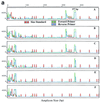New tests for syphilis: rational design of a PCR method for detection of Treponema pallidum in clinical specimens using unique regions of the DNA polymerase I gene
- PMID: 11326018
- PMCID: PMC88053
- DOI: 10.1128/JCM.39.5.1941-1946.2001
New tests for syphilis: rational design of a PCR method for detection of Treponema pallidum in clinical specimens using unique regions of the DNA polymerase I gene
Abstract
A sensitive and specific PCR method to detect Treponema pallidum in clinical specimens was developed. PCR primers were designed based on two unique features of the DNA polymerase I gene (polA). The first distinctive characteristic is that the region codes for a high cysteine content and has low homology with similar regions of DNA polymerase I gene from known microorganisms. The second unique feature is the presence of four insertions in the gene. PCR tests using primers designed on the basis these regions reacted with various pathogenic T. pallidum subspecies but did not react with nonpathogenic treponemal species or other spirochetes. An additional 59 species of bacteria and viruses, including those that cause genital ulcers, tested negative. This PCR method is extremely robust and sensitive. The detection limit is about 10 to 25 organisms when analyzed on gel. However, the analytic sensitivity can be increased by at least 1 log, to a detection limit of a single organism, when the ABI 310 Prism Genetic Analyzer is used to detect fluorescence-labeled amplicons. We further used this test in a clinical setting and compared the results with results from a previously reported multiplex-PCR test (for T. pallidum, Haemophilus ducreyi, and herpes simplex virus). We tested 112 genital ulcer specimens by the polA PCR, obtaining a sensitivity of 95.8% and a specificity of 95.7%. These results suggest that the polA PCR is applicable as a routine clinical diagnostic test for syphilis.
Figures




References
-
- Chen C Y, Ballard R C, Beck-Sague C M, Dangor Y, Radebe F, Schhmid S, Weiss J B, Tshabalala V, Fehler G, Htun Y, Morse S A. Human immunodeficiency virus infection and genital ulcer disease in South Africa. The herpetic connection. Sex Transm Dis. 2000;27:21–29. - PubMed
Publication types
MeSH terms
Substances
LinkOut - more resources
Full Text Sources
Other Literature Sources
Medical

